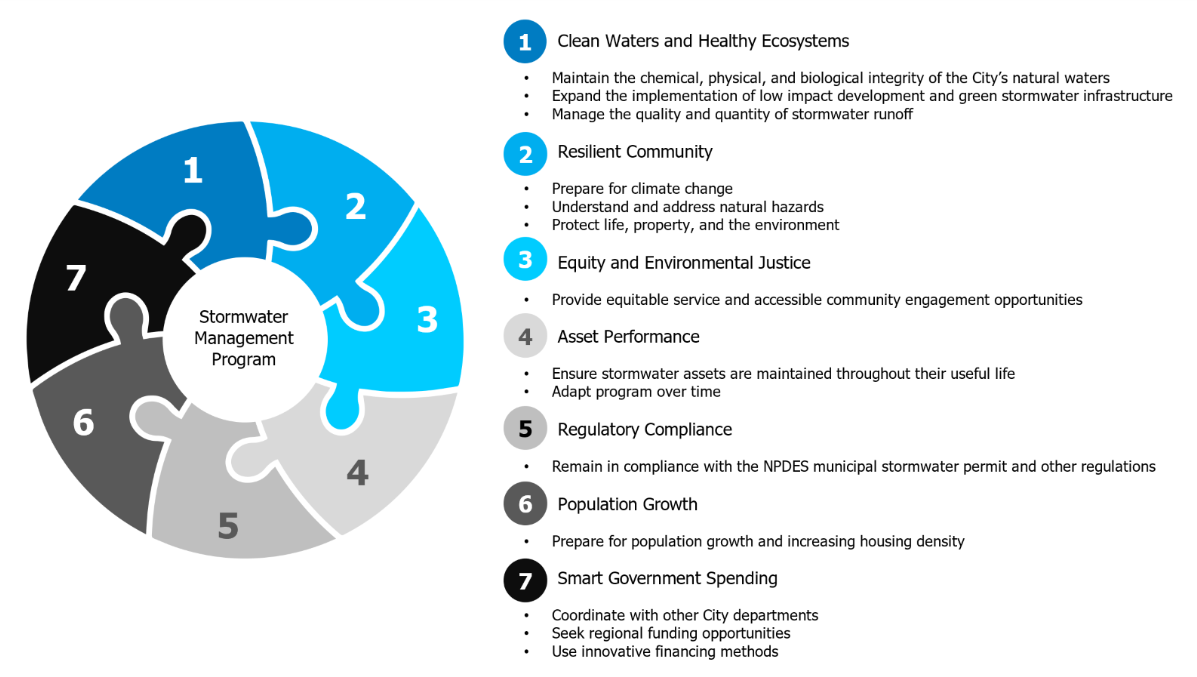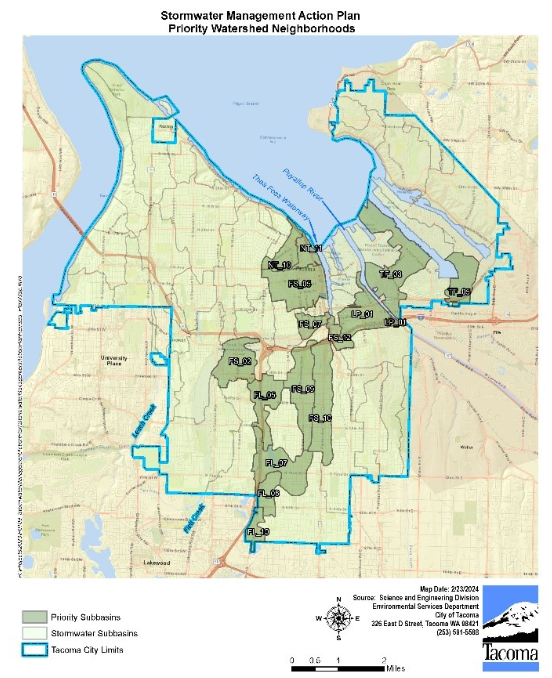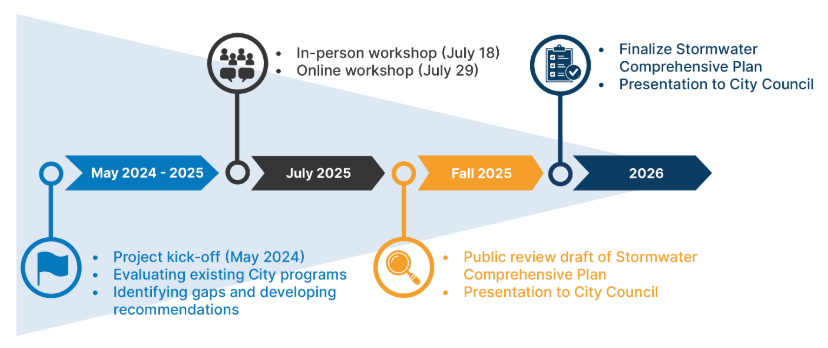
Stormwater
Environmental Services manages over 66,000 stormwater accounts and maintains a complex system of more than 500 miles of public stormwater pipes, 18,000+ catch basins, four pump stations, and numerous detention ponds and structures.
What is Stormwater?
Stormwater is the water that runs off our streets, yards, and driveways and flows directly—untreated—into lakes, streams, rivers, and the Puget Sound. That’s why our stormwater management programs focus on preventing pollution before it reaches these waters and restoring areas impacted by urbanization and industrial activities.
Help Keep Our Stormwater Clean!
Our stormwater system, which includes storm drains, catch basins, pump stations, and detention ponds, plays a crucial role in preventing flooding by moving water from your lawn to the Puget Sound. However, this system does not treat or clean the water before it reaches the Sound. That’s why it’s up to all of us to help keep pollutants out of our stormwater and protect the health of the waterways that support our fish and wildlife. Remember, if it hits the ground, it hits the sound!
Understanding Tacoma’s Stormwater System
Tacoma receives an average of 40 inches of rain annually. While you might not see a direct path from your home to the Puget Sound, rainwater from your property eventually makes its way there or to local lakes and streams, carrying pollutants it gathers along the way.
-
Tacoma has over 18,000 catch basins designed to trap large debris like garbage and leaves before stormwater enters the system. Keeping catch basins clear is essential to prevent flooding. You can help by removing debris and participating in events to mark catch basins and remind the community that they drain into local streams and the Puget Sound.
Check out our If It Hits the Ground, It Hits the Sound web page to learn more about preventing stormwater pollution.
-
After stormwater passes through a catch basin, it travels through more than 500 miles of stormwater pipes in Tacoma. In lower areas, surface water pump stations prevent flooding by keeping the water moving. Tacoma has 13 stormwater pump stations, including key locations at Flett Creek, Leach Creek, and Cleveland Way, pumping thousands of gallons of water per minute to prevent water from pooling.
-
During periods of heavy rain, detention ponds, also known as holding basins, help manage stormwater to prevent flooding. Areas like Flett Creek and Northeast Tacoma have holding ponds designed to collect and store runoff, ensuring stormwater flows gradually into local waterways.
-
Street sweeping is an essential part of keeping Tacoma’s streets and neighborhoods clean. It helps remove sediment and contaminants before they can enter the stormwater system and pollute local waterways. This practice is a critical part of Tacoma’s commitment to maintaining clean water and reducing pollutants, as outlined under the city’s NPDES permit.
To learn more and find your neighborhood’s sweeping day, visit our Street Sweeping page.
Stormwater Management & Planning
Our stormwater plans provide guidelines, strategies, and regulations to reduce pollution, prevent flooding, and enhance watershed health. Learn more about how Tacoma is working to keep local waterways clean and sustainable.
-
Tacoma’s First Stormwater Comprehensive Plan
The City of Tacoma is developing its first Stormwater Comprehensive Plan (SWCP). The SWCP directs Stormwater Management Program actions the City will take to ensure regulatory compliance, guide and identify capital improvement projects to address known flooding and water quality issues and protect habitat for fish and wildlife.
The City’s Stormwater Utility is responsible for financing the construction and maintenance of City-wide storm drainage systems in city streets and on city-owned property as well as stormwater quality monitoring, urban forestry activities, street sweeping, storm drain cleaning, business inspections, permitting for new and redevelopment projects, spill response, and stormwater related outreach and community assistance programs.
The SWCP actions proposed for City implementation over the next 25 years aim to achieve the following seven goals:

The Plan’s Vision for Clean Water and Healthy Neighborhoods:
Protecting Water and Wildlife:
We’re working to reduce pollution from stormwater (rain that runs off streets and neighborhoods) to keep our lakes, streams, and Puget Sound clean and healthy for fish, animals, and people.Preparing for Climate Change:
We’re improving our stormwater system to handle more rain and reduce flooding in neighborhoods as the weather changes.Equity for All Neighborhoods:
We want every neighborhood—especially ones that haven’t gotten enough help in the past—to have safe effective storm system, green spaces, and good stormwater services.Fixing and Cleaning the System:
We’re repairing and cleaning pipes and drains so our stormwater system works better and lasts longer.Following the Rules:
We’re meeting state and federal rules about clean water and always looking for better ways to manage stormwater.Helping Population Growth and Housing:
We’re planning stormwater projects where the city is growing to support population growth—including affordable housing—and make neighborhoods better.Spending Money Wisely:
We’re teaming up with other City projects to save money and focus on the places that need help the most—especially where clean water matters most.
The SWCP uses information from the City’s Urban Watershed Protection Plan
In 2024, the City created the Urban Watershed Protection (UWP) Plan to help protect Tacoma’s lakes, streams, and Puget Sound from pollution caused by stormwater (rainwater that runs off roads and neighborhoods).
Using mapping data, the City evaluated various neighborhood and pollution concerns to find the best places to improve stormwater systems. These improvements will help keep our water cleaner and make neighborhoods more livable.

The UWP Plan supports important City and regional goals, like:
- Clean Water and Healthy Ecosystems
- Resilient Community
- Equity and Environmental Justice
- Smart Government Spending
The plan lists top-priority projects to reduce pollution in the areas that need it most. These projects depend on the City’s budget and staffing, which are still being reviewed. More detailed designs and cost estimates will be included in the SWCP.
To learn more about the Urban Watershed Protection (UWP) Plan, visit our Watershed Planning page.
Ways to Get Involved
The City is seeking feedback on the SWCP through the following:
1. Attending a visioning workshop:
- July 18 in-person at the Tacoma Community House, 11:30 am – 12:30 pm
- July 29 online Zoom meeting | 12:00pm – 1:00pm | Register HERE
2. Providing comments on the public review draft SWCP: Fall/Winter 2025
3. Provide your email address to be notified when the draft plan is available for review.
Click the button below and reply with your email address to be notified of updates and new documents.
Get notified
Project Timeline

Project Documents
Materials will be added as they become available. Check back or sign up to get notified.
Contact Dana Deleon
Phone: (253) 502-2109Email: ddeleon@tacoma.gov -
Whether you’re planning a sewer or stormwater connection, repair, or a special discharge, the City of Tacoma requires permits to ensure projects meet safety and environmental standards. Permits not only help protect our community’s infrastructure but also play a key role in safeguarding our environment. Explore the requirements for each type of permit so your project complies with city guidelines. Here you can also learn more about the Stormwater Management Manual (SWMM) and the standards for stormwater management in Tacoma.
To learn more, visit the Stormwater Permits & Manuals page.
-
The UWP Plan helps identify and prioritize areas that require action to manage stormwater effectively. The goal is to protect people, property, and local ecosystems from the impacts of stormwater flooding and pollution by using a clear, strategic approach to problem-solving.
To learn more and find which watershed you’re part of, visit the Watershed Planning page.
-
As part of the National Pollutant Discharge Elimination System (NPDES) Phase I Municipal Stormwater Permit, the City of Tacoma maintains a comprehensive Stormwater Management Program (SWMP).
Tacoma’s Stormwater Management Program oversees the following areas through the SWMP Plan:
- Storm system mapping and maintenance
- Permitting and inspecting new construction projects
- Source control inspections
- Spill response
- Illicit discharge investigations
- Public education and outreach
The SWMP Plan ensures that the City meets federal and state requirements to reduce pollutants in stormwater runoff, safeguarding our local water bodies like lakes, rivers, and Puget Sound.
For more details about the NPDES permit or our compliance efforts, visit the Stormwater Management Program page or contact us.
Stormwater Management
Phone: (253) 591-5588
Healthy, vibrant waterways are essential to Tacoma’s quality of life. Each year, millions of pounds of toxic pollutants—such as yard chemicals, oil, grease, pet waste, and heavy metals— enter our water systems when rain carries them into storm drains, streams, and ultimately, Puget Sound.
The City has invested heavily in pollution prevention and restoration, but we need everyone’s help to keep our water clean and protect Tacoma’s natural resources. Learn more below about how you can get involved!
Additional Resources
Contact
For Water and Power Utilities,
contact:
Tacoma Public Utilities
mytpu.org or call (253) 502-8600